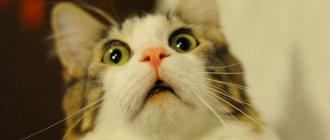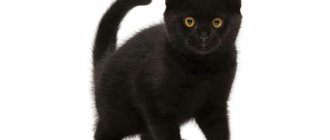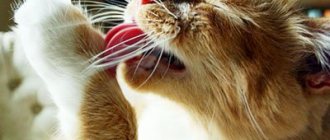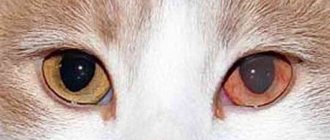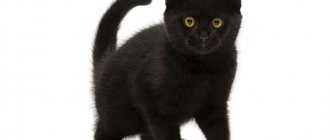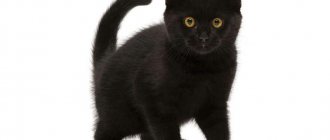Home » Useful Information
Each cat's eye color is unique in its own way. It can depend on breed, genetics and age: everyone knows that all little kittens have blue eyes. But why does this happen and how does eye color change?
- 2 When kittens change eye color
- 3 Eye color standards
- 4 What is heterochromia
Development of kittens (+ table)
Development of kittens (+ table)
Kittens are born small (weight 60-115 g, average body length 12 cm) and completely helpless, blind and deaf; all they can do is find their mother’s nipples, sleep and suck.
They cannot even get rid of excrement products on their own; to do this, the cat licks the appropriate places for them and eats their feces. However, they grow and develop quickly, and watching this process is a fascinating activity! Already a few days after birth, kittens begin to “knead” their mother’s belly with their paws, stimulating the secretion of milk (I wonder who taught them this?) They try to crawl, helping themselves with their front paws. At the age of seven days, a kitten can already crawl several tens of centimeters. At approximately 10-14 days of age, kittens' eyes begin to open.
. At this age, the eye color of all kittens is blue; it will change to the final adult color (“rebloom”) later, at the age of 3 months. At the same time, the ear canal opens and the kittens begin to hear.
In the third week
of life, kittens begin to erupt milk teeth (later they will be replaced by permanent ones). Their vision and hearing improve and they begin to explore the world around them. By the end of the first month of life, they can sit, move quite confidently and learn to play with each other. At one month of age, kittens become interested in trying foods other than their mother's milk.
Kittens older than 4 weeks become even more active and strive for independence. If before this they mainly explored their “nest,” now they are trying to get out of it. The cat spends a lot of energy maintaining order in the family and putting the children in their place. But the activity of kittens is growing by leaps and bounds, although at this age they still do not stray far from their mother. At this time, you need to place a tray next to the nest so that, following the example of their mother, the kittens become accustomed to cleanliness and neatness. Kittens that have been taught to do their business in the litter box by their mother cat will not have any problems with the toilet in the future.
From a month to one and a half months, kittens are very active, learn to lick themselves, play with each other and with their mother, and begin to eat solid food. There is an idea that at this age they can already be taken away from their mother and transferred to new owners. However, this idea is fundamentally incorrect. It is at the age of 1-3 months that kittens watch their mother and learn everything from her. Up to two months, the cat continues to feed the kittens with her milk, which provides them with good immunity to diseases. Therefore, it is not recommended to give away kittens before 2.5-3 months.
.
Complementary feeding of kittens is carried out as follows
. At the age of three weeks, kittens can be offered to drink milk from a saucer (about one teaspoon). Then you can offer some kitten food (see feeding kittens here). After a couple of days, a little baby food should be added to dairy foods, and after another week, it is recommended to replace one daily feeding with a small amount of canned meat. One month old kittens are fed approximately 4 times a day, in addition to their mother's milk. Feed portions are gradually increased. At one and a half months of age, a kitten should eat approximately 3-4 teaspoons of food per feeding.
2–3 weeks: hear, see, begin to walk
In the second week, kittens are actively developing, their hearing continues to develop, but they are not yet able to navigate by sounds. By the end of the second week, babies' eyes open, but vision does not immediately become clear. At the same time, the kitten makes its first attempts to rise on its paws; it cannot yet walk confidently.
Babies see their brothers, sisters and mother for the first time, they learn to communicate, and begin to fight for mother's milk. When they go to bed, they sit closer to each other and their mother. During this period, animals become accustomed to humans. In order for a cat to grow up tame and affectionate, you need to take them in your arms every day. At first, communication with a person lasts only a couple of minutes, but gradually the duration of contact increases.
At this stage of development, the cat controls the behavior of her cubs and teaches them the basics of hunting through play. Kittens get to know the world around them under the supervision of a cat and learn behavioral skills from her.
At three weeks, babies try to stand and move confidently, like adult cats. They estimate the distance correctly. However, weak muscles do not allow them to run quickly; kittens often fall and stumble. By the end of the period, kittens weigh about 300–400 g, they become very active, spend a lot of time playing with their brothers, love to play with toys, and can scratch behind the ear with their hind paw. They are cutting their first teeth.
You can do toilet training. To do this, you need to place the tray in a secluded but accessible place for children. If the kitten sits down to make a puddle, it must be quickly moved to the litter box.
Why do kittens' eyes change color?
Eye color in cats depends on the amount of coloring pigment. Therefore, the reason for the change in eye color is the accumulation of melanin in the eyeball during the development of the visual organs. However, blue color is a recessive trait, which is why eyes of this shade are very rare.
At the moment of embryo formation, there are approximately 3 dozen pigment centers in the body of the future kitten. Migrating throughout the animal’s body during its development, the bulk of them settle in the fur. At the same time, the eyes account for only a small proportion of pigments, which continue to accumulate after the kitten is born. In the process of their accumulation, a change in the color of the kitten’s eyes occurs.
Clinical signs
Early signs of nasal cancer in dogs and cats include unilateral nasal and/or eye discharge, nosebleeds, loss of smell, loose teeth, and sometimes scratching of the face with paws. At a later stage, signs such as deformation of the muzzle may appear on the dorsal side of the maxillary bones or over the nasal or frontal sinuses. In some cases, deformation of the facial bones in the form of protrusion/indentation is observed.
In some cases, a hard or soft, limited, protruding growth may be found around the eye or between the eyes. Sometimes deformation of the palate is observed due to softening and protrusion of the hard palate due to demineralization of bone tissue and tumor growth.
In all cases of facial deformation, there is lysis of bone tissue and tumor growth into this area. As the process spreads to the brain, seizures and behavioral changes often develop.
A complication of nasal cavity tumors is excessive mucus production. It accumulates and clogs the nasal passages and sinuses.
Physiological features affecting the color of the iris
The color of the animal depends on the accumulation of melanin pigment. There is more of it in the fur, and less in the eye area. The absence of a coloring component is indicated by the blueness of the organs of vision. The phenomenon is typical for albinos. However, the transformation of the visual organs is also associated with age-related changes.
Up to two weeks, the color of the cub's eyes is masked by a grayish film. In a growing kitten, pigment accumulates, so the color of the iris changes. The following eye colors are typical for cats:
- bluish;
- green;
- yellow;
- orange (copper).
The main tone of the kitten's eye color is formed by 17 weeks. It is at this age that a breeder should purchase a breeding animal.
Breed differences
The color of the iris is a sign of a purebred cat. For some breeds, eye color does not matter. Others - with atypical coloring - are excluded from breeding. Blue eyes are characteristic of albinos of different breeds. A distinctive feature of the British is the orange iris. For black solids, any color except green is acceptable. The standard for Siamese and Thai cats is blue.
Standards
For each purebred animal, certain standards are adopted, which specify the size of the animal, the color of the coat, and the iris.
Blue (blue)
The standard is valid for the following breeds: Siamese, Balinese, Burmese, Ojos Azules, Ragdoll, Tonkinese, Thai.
Blue irises are common in white cats. These animals have an increased risk of congenital deafness, which develops with age.
Yellow (amber)
The trait appears in the following cats: Burmese, Bombay, Korat, Kao Mani, Likoi, Turkish Van, Chausie, Carthusian.
Greens
Breeds with irises of varying degrees of intensity - from light green (gooseberry color) to emerald: Abyssinian, Burmilla, Havana Brown, Egyptian Mau, Nibelung, Oriental cat, Pixie Bob, Russian Blue cat.
When does eye color change occur?
Each cat breed changes eye color at certain times. Most often it occurs between 2 weeks and 12 months after the eyes begin to open. A kitten's eye color changes gradually. Two weeks after birth, the eyes are covered with a cloudy film. Because of this, they appear to have a gray tint. And only then the shade becomes more pronounced. From this moment you can approximately determine what eye color will be. However, you cannot be sure of this, since the range of shades is very large - from a gray-blue tint to brown. Therefore, those who get a purebred kitten and want it to have a particular eye color most often adopt it at the age of 4 months.
It is worth noting that if the kitten initially had yellow eyes, then this color becomes brighter - amber, copper or golden. That is, brown eyes can never acquire a blue tint.
Albinos
Many people mistakenly believe that albinos are individuals with white fur. In fact, albino cats have no melanin at all, meaning they are actually colorless rather than white.
Therefore, the eyes of such individuals will be pale blue or lavender. And technically it's not the hue of the iris, but a reflection of blood flow in the back of the retina.
Important! White cats with sapphire or cornflower blue eyes are definitely not albinos.
Rare colors
Amber is a new and not yet approved species. Externally similar to golden, but more subdued. The peculiarity is the presence of single black hairs located nearby.
Doubts about color are caused by the fact that dark stripes or dots are visible against a warm background, and cats, not at the genetic level, can be either black or red. For now, Amber is recognized in one of the felinological organizations for the Kuril Bobtail breed.
Kittens with the rare fawn color are a gift for many breeders. It is a variation of lilac, but a very light shade. The color of the nose is beige and pink, as are the pads on the paws. Eyes amber or copper.
This is a monochromatic color, the pigment in the hairs is evenly distributed. The quality of British wool should not suffer from bleaching, despite its apparent softness.
Cinnamon or cinnamon is a derivative of the chocolate color. The color is solid and uniform, without blemishes or marks. The shade is delicate, slightly muted. The color of the nose of the cinnamon is brownish-pink.
There are two types of shade: yellow and red. It is layered on top of the base brown. The paw pads are colored similarly to the nose.
Content Features
Despite their natural health, Britons require proper care.
To extend your cat's life, choose the right food. Ideally, you should visit a veterinarian who will create a healthy diet. Take your pet to the veterinarian regularly: the cat will not complain if it gets sick.
Wet food for cats from 12 months View product
Dry food for cats from 12 months View product
Dry food for kittens from 4 to 12 months View product
It's easy to care for the cat's fur - buy a massage slicker brush and brush your cat 2 times a week. The Briton needs to be washed a couple of times a year or as needed.
Pay attention to the animal's eyes - they are looked after every day. A cotton pad is used to remove natural discharge from the eyes, and the cotton wool is led from the outer corner to the nose. The ears are examined a couple of times a month and cleaned with cotton wool treated with a hygienic solution.
You need to examine your pet's teeth every day to prevent tartar from developing. Breeders recommend teaching your British cat to brush his teeth from an early age.
Such pets are sensitive to drafts and catch colds easily: protect your cat from drafts.
Popular misconceptions about changing eye color in cats
On many forums where inexperienced breeders begin to advise cat lovers on how to care for them, incorrect information comes across. Popular misconceptions about eye changes in cats include the following facts :
- All kittens, without exception, initially have a blue-gray tint to their eyes.
- There is a relationship between fur color and iris color.
- The color of the iris depends on the kitten's diet.
Each of these theories has no scientific proof. But despite this, breeders are taking measures to breed cats with exactly the eye color that is becoming the standard.
Pathology
Pathology reports classify most canine nasal cavity tumors as cancer. Adenocarcinomas of the respiratory tract are the most common, followed by squamous cell carcinoma and several other types, as well as undifferentiated carcinoma.
Approximately one third of nasal tumors in dogs are sarcomas, the most common being fibrosarcoma, followed by chondrosarcoma, osteosarcoma, lymphoma and other types, and undifferentiated sarcoma.
A publication from the University of North Carolina described 320 cases of nasal tumors in cats, 60% of which were cancers, 18% were sarcomas, and 12% were lymphomas.
There was no correlation between the grade of malignancy and survival. However, some tumors have a lower mitotic rate, slower growth, or less aggressive biological behavior than others, such as low-grade chondrosarcomas.
Common Misconceptions
On the Internet you can find many myths and misconceptions related to the process of “repainting” cat eyes. Here are just a few of them:
- All newborn kittens must have bright blue eyes. Some believe that deviations from this “norm” threaten serious pathologies. In practice, it happens that kittens’ eyes can be colored in different gradations of gray and blue colors... And all this is the norm. If the iris of a recently born kitten is not blue, this is not a pathology!
- There is a common misconception about the correlation between coat color and eye color. This opinion is partly true. But only for representatives of certain breeds whose coat color was “tied” to the color of the iris during a long and difficult selection process. It’s just that in their case, the eye color can actually be anything, and this is also not considered a deviation.
- Some breeders are truly convinced that eye color depends on... diet. But this “theory” is absolutely not confirmed either by science or by practical observations of breeders. It is known, however, that frequent feeding of fish can cause a cat’s fur to noticeably darken, but even in this case, its eyes will not change color.
We invite you to read: What types of discharge can occur in cats after giving birth and when treatment is required
Dichromatic eyes
In this case, the pet has two shades of the iris on one eye. Sometimes it looks like a colored ring around the pupil of a different shade, or the eye is divided into two different colored fragments.
Important! Judges at professional cat shows consider this a disadvantage, but amateurs consider it a cute and attractive feature. Sometimes mirror dichromacy occurs in both eyes at once.
What do they say about cats with blue eyes?
Cat eyes have four primary colors – blue, green, yellow and copper. What eye color your pet will have depends on genetic characteristics. If he is predisposed to the presence of a large number of melanocytes, then his eyes will be dark, if there is little of this pigment, they will be light.
There are no blue eyes as such. If a cat has eyes of this shade, then its body does not produce enough pigments. We simply mistake the reflection in their transparent part for the blueness of the eyes. However, scientists have not established a connection between a cat’s health and its life expectancy.
Differences with human vision
Of course, it's all about the brain. Unlike humans, cats have developed areas of the brain that are responsible for hearing and smell, so vision in cats is worse than these senses. In humans, most of the neurons are taken away by hand motor skills.
Unlike other creatures, a cat's vision is an auxiliary sense, and not the main one - hearing and smell are considered the main ones. Evolution put everything in its place due to the fact that the cat is considered an animal that hunts from an ambush. That is why she does not need a far-sighted gaze of several kilometers.
Dogs see better than cats, and this is also due to brain development. The structure of the limbs and their work in the cat family is much more complex, therefore, together with the development of areas responsible for hearing and smell, there is no room left for vision on the surface of the cerebral cortex in cats, and they see worse.
What is heterochromia
Heterochromia is the presence of different colored eyes in one cat. There are two types of heterochromia:
- complete - both eyes are completely different in color;
- sectoral - part of the eye (from a quarter to three quarters) of a different color.
Heterochromia can be either congenital or acquired. Congenital is formed under the influence of genes, acquired can appear due to injury or after illness. Congenital heterochromia is also associated with the movement of pigment - if one eye falls into an area where less pigment moves, it may be a different color from the genetically determined one.
Heterochromia can appear in any variations: brown and blue, brown and green, green and blue, copper and brown, copper and yellow, etc. But most often it is blue and yellow.
Heterochromia is also called heterochromia
Any cat can have heterochromia, even a purebred one, but for some breeds the standard considers heterochromia to be normal, while for others it is not. Which breeds can be heterochromic according to the standard:
- Kao-mani.
- Turkish Angora.
- Turkish van.
- Minskin.
- Munchkin.
- Ojos azules.
- Canadian Sphynx.
- Don Sphynx.
- Some colors of British and Scottish cats (for example, solid white).
As a rule, you can understand what eye color a kitten will have as early as 4 months. It is at this age that you should take kittens if you want a certain eye color.
Red eyes only occur with albinism
Little kittens are adorable in large part due to their beautiful blue eyes. For some, this color remains for life, for others it changes at a certain age. But the main thing is that the color of a cat’s eyes does not determine its character at all. A cat with any eye color is beautiful, and any cat can become a devoted and affectionate pet for you.
WHEN DO BRITISH KITTENS OPEN THEIR EYES AFTER BIRTH?
After birth, kittens' eyes open at about 7-10 days, less often at 14-15 days.
Interesting! If kittens lie in a dark box, they open their eyes earlier.
At this age, the eyes are watery and very sensitive, so at this age it is better not to expose them to bright lighting, the sun and not to take photographs.
WHEN DO BRITISH KITTENS CHANGE EYE COLOR?
Kittens are always born with blue eyes. This eye color lasts up to 1.5-2 months, then they begin to change color to their main eye color, which matches the color.
VARIETIES OF BRITISH EYE COLOR
The British have four types of eyes:
- Blue eyes - blue, designated by BRI code 61
- Yellow eyes (orange, golden, copper, etc.) - yellow, golden, indicated by BRI code 62
- Different eyes - odd eyed ("with odd eyes"), indicated by BRI code 63
- Green eyes - green, designated by BRI 64 code
Let's talk in more detail about each eye color.
BRITISH CATS WITH BLUE EYES
The beautiful blue eyes of British cats are found only in color point and other white colors.
The cat's body is point-colored, with white and dark markings on the face (mask), ears, and tail.
White British cat with blue eyes (indicated by BRI code w 61). Such cats are sometimes deaf, so the kittens are carefully examined by a veterinarian.
Color point British cat with blue eyes (BRI b 33 61)
British cat, point silver chinchilla with blue eyes (BRI ns 33 61)
British cat white with blue eyes (BRI w 61)
British kittens with blue eyes, point tabby color (BRI ns 21 33 61)
BRITISH CATS WITH YELLOW EYES
It should be noted that most British cats have yellow (golden) eyes. This is according to the breed standard. The eyes of British kittens turn yellow after 2 months.
Colors of British cats with yellow eyes:
- plain (black, blue, chocolate, lilac, cinnamon, fawn, red, cream)
- colors with white (bicolor, van, harlequin)
- tabby – cats with a pattern – spotted, striped, marbled, ticked (except golden color)
- tortoiseshell colors
- white (white colors are found not only with yellow eyes)
British blue (gray) cat with yellow eyes (BRI a 62)
British black cat with yellow eyes (BRI n 62)
British cat with yellow eyes, color cream bicolor (BRI e 03 62)
British lilac kittens with orange eyes (BRI c 62)
White British cat with yellow eyes (BRI w 62)
British cat with yellow eyes, chocolate spotted color (BRI and 24 62)
BRITISH CATS WITH DIFFERENT EYES
Found only in white cats
These cats look very impressive, unusual, and attract attention.
British white cat with different eyes (BRI w 63)
BRITISH CATS WITH GREEN EYES
British cats with green eyes only come in silver and gold colors (chinchilla and tabby).
Moreover, the golden color should always only have green eyes, while the silver ones have both green and yellow eyes.
Golden cats with yellow eyes are rejected. The British golden cat (looks like a red cat) with green eyes looks bright and elegant. Today this is a relatively new color, bred by felinologists.
British golden cat with green eyes (BRI ny 25 64)
Silver chinchilla, British cat with green eyes (BRI ns 11 64)
British cat with green eyes, marbled color (BRI ns 22 64)
EYE CARE FOR A BRITISH KITTEN
Due to the characteristics of the British breed and their short baby-face muzzle, the nasolacrimal duct takes a long time to form, so the kittens develop tear discharge. Eye care includes rubbing your eyes daily.
HOW TO WASH AND WHAT TO WIPE A BRITISH KITTEN'S EYES?
The best way to wipe the British eyes is with a cotton pad moistened with boiled water. You need to use a different cotton pad for each eye. It is not recommended to wash your British kitten's eyes with herbal tea, because... they leave marks on the fur. Sometimes, if there is excessive tearing, you can use “diamond eyes” drops; they wash the eyes well and dry them a little to reduce the discharge.
Closer to the year, the discharge from the British eyes is reduced to a minimum or disappears completely.
In our nursery there are British kittens with eyes: yellow, green, blue, odd-eyed.
Cat breeds and eye colors
As mentioned above, breed is not a 100% factor in whether an animal's eyes are a particular color. However, people are accustomed to certain standards and the norm for them is a specific eye color in individuals of certain breeds :
- British breed - bright orange or amber hue.
- Russian Blues have green eyes.
- White British people have blue eyes.
- Black layer - eyes should not be green.
- Scottish cats are green or copper in color.
By paying attention to the fact that kittens' eyes change, you can determine their age.
Green-eyed breeds
Long-haired and short-haired Persians with a chinchilla-colored coat are known for their green eyes with a black “rim.” The Tonkinese breed has striking sea green eyes.
Russian Blue cats have emerald green eyes that contrast beautifully with their gray-blue coat. And the Egyptian Mau's irises resemble juicy gooseberries.
Colors of Shorthair Scottish Fold cats (Scottish Fold Colors)
White (WHITE)
: Pure white, shiny. Eyes: deep sapphire blue or gold. A white with different eyes should have one eye sapphire blue and the other golden with equal color saturation. Nose and paw pads: pink. Black (BLACK)
: Black, coal without any rusty mixture.
Painted along the entire length. Nose is black. The pads are black or brown. The eyes are golden. Blue (BLUE)
: blue, preferably light blue, uniform.
Equally darkish is preferable to light with transitions and shades throughout the body. The nose and pads are blue. The eyes are golden. Red (RED)
: deep brilliant red, uniform, without smoke, pattern or ticking (at least see this in person, reds always have smoke, tabi, etc.).
White hairs are not allowed. Nose and pads: brick red. The eyes are golden. Cream (CREAM)
: Light shades are preferable, the color is uniform throughout the body. Nose and paw pads: pink. The eyes are golden.
How do kittens' eyes change?
The final eye color in cats is established by the age of 2 years. The process of changing the color of the iris is called reblooming. Most often it begins in the 4th week of a kitten’s life. In this case, the usual blue tint of the eyes is diluted with splashes of a different color. Gradually, these inclusions grow and the animal’s eyes acquire a constant shade.
Sometimes in white cats you can observe a difference in eye color. For example, one of them is green and the other is blue. This phenomenon is called heterochromia. Most often it is found among Turkish Vans, in rare cases among representatives of the British, Scottish or Persian species. Cats' eyes can not only change color, but also fade with age. At the same time, once bright shades turn into dull ones.
So, if you have a preference for cats with a certain eye color, adopt a kitten at 4 months of age. At this time, it is already possible to determine what color of the pet’s iris will be. Later it may acquire greater depth and richness, but its basic tonality will remain unchanged. It is worth noting that eye color is not a feature of a particular breed. This is a purely genetic criterion, where blue color is a recessive trait.
Myths regarding beautiful cat eyes
- The color of the iris can be adjusted by diet. Regardless of the quantity, quality and a certain set of products, the iris will acquire its “genetic” color;
- All kittens have blue eyes at birth. Wrong! The shade depends on the amount of melatonin, and this indicator varies among different breeds already at the time of birth;
- The darker the fur, the darker the eyes. In principle, everything is correct - darker wool implies a greater amount of pigment, which “darkens” all the external organs of the animal. But there are exceptions - for example, Felis catus, known as the blue-eyed cat. Representatives of this breed with a dark coat color may have bright blue eyes.
How to find out the age of a kitten
Every owner should know how old his pet is. It's easy to see the difference in what a 1 month or 1 week kitten looks like in appearance. It develops at a rapid pace, at each specific stage there are characteristic signs that indicate an approximate date (only a veterinarian can say for sure). There are certain ways that will help you find out how old your pet “predator” is. The time of birth can be determined using the following criteria:
How kittens grow
The surest way to determine the age of a kitten is by observing it. There are certain periods of development of an organism that indicate the date of its birth. The older the pet, the more difficult it is to know exactly how old he is. The easiest way to do this is before 1 month, when the main stages of the formation of all animal body systems occur:
- the umbilical cord disappears;
- the baby begins to stand on his feet;
- body weight increases;
- eyes open, their color changes;
- teeth appear and grow.
Pathological causes
There are hereditary disorders and diseases in which the organs of vision change color:
- genetic abnormalities;
- ophthalmological diseases.
Heterochromia is considered a congenital defect that does not affect health. Most often, unequal coloring of the right and left eyes is observed. Sometimes segments of one of the irises are colored differently. The anomaly is a consequence of uneven distribution of pigment. A high percentage of heterochromia is observed in Angora cats. The phenomenon is considered a deviation from the norm, and such individuals are excluded from breeding.
Heterochromia

